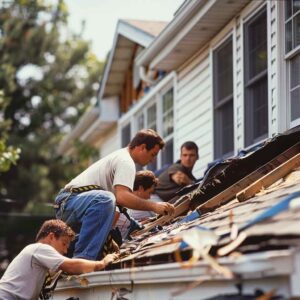We’re here to tell you all about built-up roofing. It’s a popular roofing system that’s been around for years.
We’ll explain how it’s constructed and the layers involved. Plus, our roofing experts cover the advantages and benefits it offers. If you’re considering installing built-up roofing, we’ve got some critical considerations for you.
And don’t worry about roof maintenance and longevity – we’ll provide expert tips to keep your built-up roof in top shape.
Get ready to learn everything about built-up roofing!
History and Origins
Let’s delve into the history and origins of built-up roofing. Built-up roofing, also known as BUR, has a rich history that dates back to ancient times.
The evolution and improvements of BUR have greatly influenced modern roofing techniques. BUR was first documented in ancient Egypt, where it was used to protect buildings from the scorching desert sun.
Over the centuries, BUR has undergone significant advancements in materials and installation methods.
In the 19th century, the introduction of asphalt and coal tar revolutionized BUR, making it more durable and weather-resistant.
These enhancements set the stage for BUR to emerge as a favored option for commercial buildings in the early 20th century.
Today, BUR continues to be a reliable and cost-effective roofing option, thanks to its long-standing history and influence on modern roofing techniques.
Construction and Layers
We will now delve into the construction and layers of built-up roofing, continuing our discussion from the previous subtopic.
Known as BUR, built-up roofing is renowned for its durability and longevity, making it a favored choice for commercial and industrial buildings. The construction of a BUR system involves multiple layers of materials.
The base layer is typically a substrate, such as plywood or concrete, which provides structural support. On top of the substrate, multiple layers of roofing felt, also known as ply sheets, are applied.
These ply sheets are saturated with bitumen, a dense and sticky material that acts as a waterproofing agent.
Finally, a top layer of gravel or a reflective coating is added to protect the roof from UV rays and provide additional waterproofing.
The installation process of BUR involves hot or cold application methods, with the bitumen being heated or applied with a cold adhesive. The materials utilized and the exact installation process may differ based on the specific requirements of the project.
Advantages and Benefits
A key benefit of built-up roofing is its remarkable durability and extended lifespan. Crafted to endure challenging weather, this roofing system can endure for multiple decades with appropriate maintenance.
Here are some key benefits of built-up roofing:
– Energy Efficiency: Built-up roofs provide excellent insulation, reducing heat transfer and minimizing energy consumption. This can result in lower heating and cooling costs.
– Cost Effectiveness: While the initial installation cost of built-up roofing may be higher than some other roofing options, the long lifespan and minimal maintenance requirements make it a cost-effective choice in the long run.
– Fire Resistance: Built-up roofs are highly fire-resistant due to the multiple layers of materials used in their construction. This can provide peace of mind and added safety to building owners.
– Versatility: Built-up roofing can be adapted to various roof shapes and sizes, making it suitable for various commercial and industrial applications.
Considerations for Installation
Before beginning the installation of built-up roofing, it is essential to consider several vital factors carefully. These include installation factors and cost considerations.
When it comes to installation factors, it is crucial to assess the condition of the existing roof structure. Any repairs or reinforcements needed should be addressed before proceeding with the installation.
Additionally, the type of substrate and insulation used can impact the installation process and overall performance of the roofing system.
As for cost considerations, evaluating the total cost of materials, labor, and any additional equipment or tools required for the installation is essential.
The chosen roofing system’s long-term maintenance and repair costs are also worth considering. Properly considering these factors will ensure a successful and cost-effective installation of built-up roofing.
Maintenance and Longevity
How often should built-up roofing be inspected? Regular inspections are crucial for maintaining the longevity of built-up roofing.
Here are some maintenance tips and common problems to be aware of:
– Conduct inspections at least twice yearly, preferably in spring and fall.
– Clear any debris from the roof surface, such as leaves or branches.
– Check for signs of ponding water, which can lead to leaks and structural damage.
– Inspect the flashing and seams for any signs of deterioration or damage.





